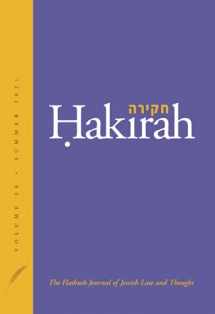
Hakirah: The Flatbush Journal of Jewish Law and Thought (Volume 30)
Book details
Summary
Description
The first essay, “Rabbi Joseph B. Soloveitchik’s Remarks at the Ḥanukat Ha-Bayit of the Talner Shtibel”discusses the role of the beit ha-kenesset as the house of the Jewish people and remarks on the special warmth the Rav feels for the chasidishe beit midrash. By contrast, in“R. Soloveitchik and R. Shubow” we read a hesped for a close friend who was a Conservative rabbi. Here the Rav expresses his warm feelings and admiration for his friend, while in a letter written sometime earlier, he explains why he must distance himself from that friend’s synagogue. In an articletitled “The Rav at Revel; The Rav at RIETS,” a talmid who is the note-taker of the Genesis notes, describes how Rav Soloveitchik, the Rosh Yeshiva, differs from Professor Soloveitchik, the teacher of philosophy.In “Rabbi Joseph B. Soloveitchik’s Portrayal of the Patriarchs,”the author seeks to demonstrate that the Rav’s portraiture of the Patriarchs is “... the direct result of the way he viewed the Jewish concept of time, masorah (tradition), and the covenantal community.” And in “Recollections and Reconstruction of a Debate on the Nature of Kedushas Eretz Yisrael,” the authors record the disagreement between the Rav and Rav Shlomo Goren in an issue of lomdut with important practical ramifications. Together, these articles shed light on the complex personality of the Rav.
Our Torah and Medicine section deals with issues that are new either because of advances in technology or because of attitudinal changes in society. The first article in the section,“Danger in Sabbath Law: A Novel Perspective Using Causality and Statistics,” deals with the development of objective standards for qualifying treatments as worthy of being described as pikuaḥ nefesh in regard to Shabbos. The second article, “Halachic Issues Related to Synthetic Biology,”addressesimportant halachic implications arising from developments in this field. A third article, “It Is Legal and Everyone Is Using,” deals with whether recreational marijuana is permitted in halakhah. “Mental Distress and Ḥoli” raises a question, not yet resolved in halakhah, as to whether conditions involving mental distress should be considered illness and the sufferer categorized in halakhah as a ḥoleh.
Other articles deal with Torah and Science. In “How Science Deepens Our Understanding of Torah: (i) The Rainbow and the Photon and (ii) Rain and Chaos”the author seeks to demonstrate that Torah can help us better understand principles of modern science. In “The Number of Kinnim Revisited” the author claims that a deeper understanding of math can help in understanding the thinking of the Tannaim 2000 years ago.
In our Minhag section, two articles titled “The Number of Candles in the Context of Mitzvat Ner Shabbat” and “A Shabbat Candle for Every Member of the Family” give different perspectives about the origins of minhagim regarding the number of candles to light erev Shabbos. And “Blessed Are the Cheesemakers: In Search of Ancient Roots of Dairy on Shavuot”suggests novel ideas about the origin of another well-established minhag.
In the Jewish Thought section, in the essay titled “Ibn Ezra: ‘The All Knows Every Part via the All,’”the author clarifies a perplexing explanation of Ibn Ezra on G-d’s knowledge and shows how what was thought by some to be a radical position is well within mainstream thought.


We would LOVE it if you could help us and other readers by reviewing the book
Book review



